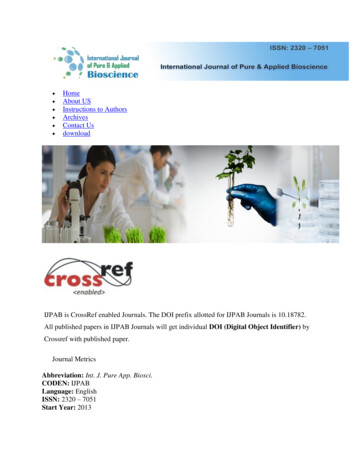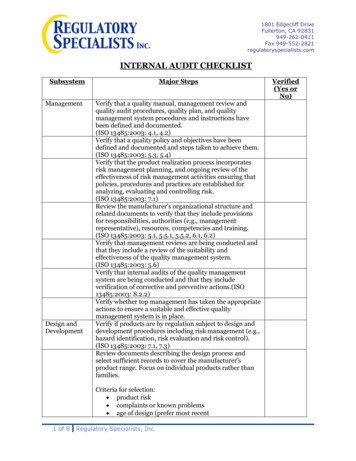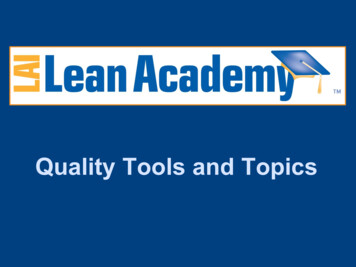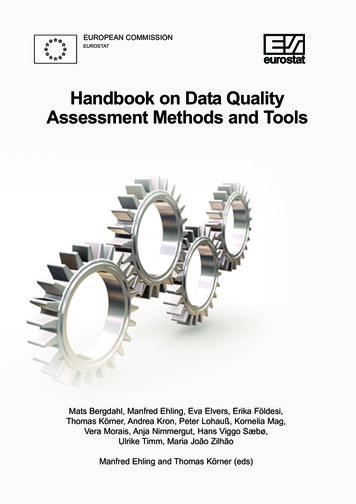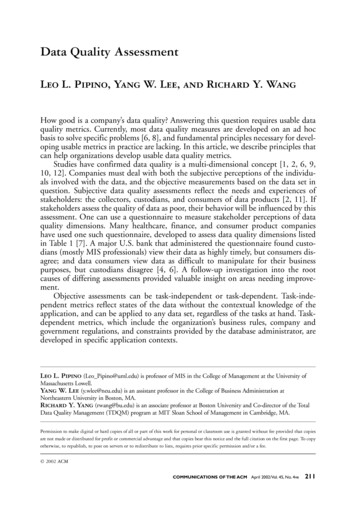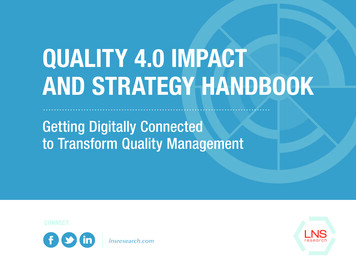
Transcription
QUALITY 4.0 IMPACTAND STRATEGY HANDBOOKGetting Digitally Connectedto Transform Quality ManagementCONNECT:lnsresearch.com
QUALITY 4.0 IMPACT AND STRATEGY HANDBOOKGetting Digitally Connected to Transform Quality ManagementTABLE OF CONTENTSSECTION 1: Executive Summary . . . . . . . . . . . . . . . . . . . . . . . . . . . . . . . . . . . . . . . . . . . . . . . . . . . . . . . . . . . . . . . . . . . . . . . . . . . . . 3SECTION 2: Defining Quality 4.0 . . . . . . . . . . . . . . . . . . . . . . . . . . . . . . . . . . . . . . . . . . . . . . . . . . . . . . . . . . . . . . . . . . . . . . . . . . . . . 7SECTION 3: Understanding the 11 Axes of Quality 4.0 . . . . . . . . . . . . . . . . . . . . . . . . . . . . . . . . . . . . . . . . . . . . . . . . . . . . . . 11SECTION 4: Summary and Recommendations . . . . . . . . . . . . . . . . . . . . . . . . . . . . . . . . . . . . . . . . . . . . . . . . . . . . . . . . . . . . . . 26ACRONYMQUICK REFERENCEVIEW ON BLOGlnsresearch.com
SECTION 1Executive Summary
Executive SummaryPAGEQUALITY 4.0 IMPACTAND STRATEGY HANDBOOK4TABLE OFThe most recent decade has seen rapid advances in connectivity, mo-for Industry 4.0. Quality 4.0 is closely aligning quality managementbility, analytics, scalability, and data, spawning what has been calledwith Industry 4.0 to enable enterprise efficiencies, performance, in-the fourth industrial revolution, or Industry 4.0. This fourth industrialnovation and business models. However, much of the market isn’trevolution has digitalized operations and resulted in transformationsfocusing on Quality 4.0, since many quality teams are still trying toin manufacturing efficiency, supply chain performance, product in-solve yesterday’s problems: inefficiency caused by fragmented sys-novation, and in some cases enabled entirely new business models.tems, manual metrics calculations, quality teams independently per-This transformation should be top of mind for quality leaders, asforming quality work with minimal cross-functional ownership, andquality improvement and monitoring are among the top use casesineffective supplier communication, among others.What are the top IIoT use cases your companyis pursuing today? (N 252, all respondents)What are the top IIoT use cases your company will startpursuing in the next year? (N 249, all respondents)CONTENTSSECTION1 23 429%25%24%Remote monitoringEnergy efficiencyAsset reliability23%23%22%19%Quality improvementProduction visibilityInternet enabled productsBusiness model transformation,e.g. selling capacityAsset and material trackingCustomer access to informationImproving safetyProduction visibility5%10%18%18%15%12%Energy efficiencyInternet enabled productsTraceability and serializationSupplier visibility8%Improving safetyImproving environmentalperformance5%0%21%21%20%19%Customer access to information6%Supplier visibilityImproving environmentalperformanceAsset reliabilityBusiness model transformation,e.g. selling capacityAsset and material trackingQuality monitoring19%17%15%12%Traceability and serialization26%23%22%Remote monitoring15%20%25%30%35%5%0%5%10%15%20%25%30%
Executive Summary (Cont.)PAGEQUALITY 4.0 IMPACTAND STRATEGY HANDBOOK5TABLE OFCONTENTSInterestingly, a vast number of existing quality-centered Industry 4.0systems and compliance. Although it’s an advanced topic, this alsoinitiatives are not being led by quality, but by IT, operations, engi-isn’t a story about tomorrow, since leading manufacturers are al-neering, or sales and marketing. Many conversations with qualityready on their Digital Transformation journey. This eBook providesleaders make it clear that a large portion of them do not possess amanufacturers with the tools and insights required to lead the Qual-clear understanding of Industry 4.0 technologies, their application,ity 4.0 transformation. It communicates the technologies, how theyand their importance. This lack of understanding is preventing quali-transform people and processes, existing concrete accomplishmentsty from effectively leading the charge on Quality 4.0.by peers, and guidance to enable the transition from traditional qual-Quality 4.0 isn’t really a story about technology. It’s about howity to Quality 4.0. Regardless of who leads the Quality 4.0 transfor-that technology improves culture, collaboration, competency andmation, those that apply the technology to greatest effect will be theleadership. It’s also about the digital transformation of managementinnovation leaders of tomorrow.Which roles are planning to use IIoT to monitor and improve quality?SECTION1 23 421%22%Information TechnologyQuality Improvement DataQuality Monitoring Data15%Research andDevelopment13%14%Engineering10%QUALITY 4.0 isn't really a story abouttechnology. It's about how that technologyimproves CULTURE, COLLABORATION,COMPETENCY, AND Y0%5%10%15%20%25%30%
Why Quality 4.0?PAGEQUALITY 4.0 IMPACTAND STRATEGY HANDBOOK6Quality 4.0 is a reference to Industry 4.0. The First (real) Industrialand natural worlds. Several critical technology changes have enabledRevolution embodied three revolutionary changes: machine manufac-this, including advances in data, analytics, connectivity, scalability, andturing, steam power and the move to city living for people who hadcollaboration. As the fourth revolution takes hold, it will impact every-previously been agriculturalists. During the Second Industrial Revolu-thing that we do. It connects people, machines and data in new ways,tion, the production line and mass manufacturing drastically reducedit democratizes technologies that were previously only accessible tothe cost of consumer and industrial products. The Third Industrialthe specialized few, and ushers in transformative capabilities such asRevolution was barely a revolution as electronics and control systemsthose in material science and 3D Printing. For quality, these technol-gradually penetrated manufacturing, allowing greater flexibility andogies are important because they enable transformation of culture,more sophisticated products at a significantly lower cost. The Fourthleadership, collaboration, and compliance. Quality 4.0 is truly notIndustrial Revolution is happening around us right now. It extends theabout technology, but the users of that technology, and the processesdigital impact of the third revolution and merges it with the physicalthey use to maximize value.TABLE OFCONTENTSSECTION1 23 4FROM INDUSTRY 1.0 TO INDUSTRY 4.0DEGREE OFCOMPLEXITYFIRSTSECONDTHIRDFOURTHIndustrial RevolutionIndustrial RevolutionIndustrial RevolutionIndustrial RevolutionThrough the introduction of mechanicalproduction facilities with the help ofwater and steam powerThrough the introduction of a divisionof labor and mass production withthe help of electrical energyThrough the use ofelectronic and IT systems thatfurther automate productionThrough the use ofcyber-physical systemsFirst mechanical loom, 17841800First assembly line, Cincinnatislaughter houses, 18701900First programmablelogic controller (PLC),Modicon 084, 19692000Today DFKI, 2011
SECTION 2Defining Quality 4.0
What is Quality 4.0?Quality 4.0 certainly includes the digitalization of qualitymanagement. More importantly it is the impact of thatdigitalization on quality technology, processes andpeople. LNS has identified 11 axes of Quality4.0, which companies can use to educate,GESESNAOGvides a perspective on traditionalDATAMAinitiatives. The framework also pro-OCcan transform existing capabilities andENEMLENTNOOPMC H DEVELPAPsearch, leaders identify how Quality 4.0Mplan, and act. Using this framework and re-TSTYSANALY TICSTEYQUALITY 4.0 IMPACTAND STRATEGY HANDBOOK8PRPAGEquality. Quality 4.0 doesn’t replacethe framework to interpret theircurrent state and identify whatchanges are needed to move toSCCULTU REthe future state.ALAYCOLIONORATL ABC O M PE T EPEOPLEN CYLE ADERSHTRADITIONALQUALITYBIPQUALITY 4.0IT1 23 4them. Manufacturers should useC ONNEC T I V I T YSECTIONrather builds and improves uponILCONTENTSCOMPLIANCEtraditional quality methods, butTABLE OF
USE CASE 1: Managing Recipe VariationPAGEQUALITY 4.0 IMPACTAND STRATEGY HANDBOOK9TABLE OFCONTENTSSECTION1 23 4Let’s bring the framework to life with some examples. Brewing beerprocess data to solve a batching problem that was causing a majoris a touchy process that must balance the relationships betweenquality issue and the loss of entire batches.live cultures, bacteria, time, ambient and equipment temperatures,The brewmasters thought the problem was the relationship be-ingredients, equipment, elevation, and much more. The inherenttween pressure and temperature; instead it was an issue with the tim-variation can cause quality issues.ing of batch processes determined by natural variances in yeast. TheyOne of the largest craft brewers in the US recently implement-used ML/AI to build a model to alter the recipe and optimize batchesed machine learning (ML), artificial intelligence (AI) and historicalon previously unknown relationships. By establishing a new process,the brewer eliminated lost batches associated with this quality issueand recaptured two weeks of extra capacity per lost batch.TAKEAWAY:Original Pale AleFAVORITESAVEPRINTThe brewmasters applied Quality 4.0 analytics to traditional data andprocesses to drive quality improvement and new competencies.INGREDIENTS FOR 1000 GALLONS1000 lb. pale malt200 oz. Amarillo hop pellets250 lb. honey oats200 oz. Citra hop pelletsdry hop after FG40 lb. honey malt40 oz. hop pellets 8%150 oz. Citra hop pellets 12%DIRECTIONSMash 1000 lb. pale 2-row malt with flaked and honey malts at 152 Ffor one hour.Drain, rinse grains, and dissolve 50 lb. pale maltextract syrup into resulting wort.Top off with reverse osmosis or distilled water todesired boil volume and proceed as above.Original Pale Ale10 lbs. pale malt2.5 lb honey oatshalf pound Malt1 ounce. hop pelletshalf-ounce hops 8%2 lb mashed maltdry hop Gafter FMash 3 lb. pale 2-rowmalt with flaked andFhoney malts at 152 for one hour.Drain, rinse grains, anddissolve 5 lb. pale maltextract syrup intoresulting wort.Top off with reverseosmosis or distilledwater to desired boil asvolume and proceedabove.
USE CASE 2: Supplier Quality ManagementPAGEQUALITY 4.0 IMPACTAND STRATEGY HANDBOOK10TABLE OFCONTENTSSECTION1 23 4Supplier quality management (SQM) is a leading roadblock to achiev-The company also expanded this approach to the supply chain toing quality objectives. Suppliers continue to grow in importance asanalyze data in its existing enterprise SQM technology and manufac-their percentage of end products grows, and quality teams have beenturing execution systems with ML/AI. The ML/AI analyzes incomingworking diligently to adopt mature SQM processes and technology.inspection data, and in some cases data from final testing performedOne large contract manufacturer has a Digital Transformationat supplier facilities. The contract manufacturer can now identify is-strategy that encompasses manufacturing and it has deployed Cloud,sues with their suppliers’ manufacturing processes before suppliersbig data and ML/AI to improve tracking of machine performance. Us-do, which enhances non-conforming material process and impactsing the new approaches, the manufacturer can predict and remedysupplier risk profiles.machine downtime and product quality issues before they happen.As a result, the company increased up yield and reduced manufacturing cycle time.TAKEAWAY:Quality 4.0 is a journey; there’s value in a common data model andanalytics, and Quality 4.0 has an impact on management systemprocesses and culture.
SECTION 3Understanding the11 Axes of Quality 4.0
Datathe importance of evidence-based decision making. However, indus-CAPAs are low velocity, whiletry has a long way to go. As shown in the chart, much of the marketstatistical process control (SPC)continues to struggle with evidence while more mature companiesdata is high velocity, and a glob-have mastered traditional data and are now leveraging big data.al fleet of connected devicesReal time visibility ofquality metrics in.Median adoption byinnovation leadersIn God we trust;all othersbring data.—W. Edwards Demingstreaming data is even highervelocity.All othersCustomer service83%43%Supplier 9%Across all four areas65%22%VERACITY: This refers to dataaccuracy. Quality system data is often low veracity due to fragmented systems and lack of automation.TRANSPARENCY: Consider for a moment the ease of accessing and working with data no matter where it resides or whatapplication created it. Leaders should work to develop a common data model to combine structured business system datalike inventory transactions and financial transactions withLet's break down what data is and how to think about it. Data hasstructured operational system data like alarms, process pa-five important elements to consider:structured, and semi-structured. Structured data is highly organized (CAPAs, quality events). Unstructured data is unorganized (e.g. semantics data, data from sensors and connecteddevices). Semi-structured data is unstructured and has hadstructure applied to it (e.g. metadata tags).TRADITIONAL DATATransparency (low to high)VARIETY: Systems gather three types of data: structured, un-events, with unstruc-Veracity (low to high)proaches such as data lakes.Velocity (low to high)nected devices is many orders greater, requiring special ap-Un-structuredquality events, etc.). However, the volume of data from con-Semi-Structuredtional records (e.g. corrective and preventive action (CAPA),(low to high)VOLUME: Traditional systems have a large quantity of transac-rameters, and qualityBIG DATAStructured1 23 4which a company gathers data.VarietySECTIONments for decades. Many recently updated standards re-emphasizeVolume (low to high)TABLE OFCONTENTSVELOCITY: This is the rate atQUALITY 4.0QUALITY 4.0 IMPACTAND STRATEGY HANDBOOK12Data-driven decisions have been at the heart of quality improve-TRADITIONAL QUALITYPAGEtured internal andexternalcustomer,datalikesupplier,Web, and machinedata to provide highveracity and transparency.
AnalyticsPAGEQUALITY 4.0 IMPACTAND STRATEGY HANDBOOK13Analytics unlock the insights captured within data. Today, analyticsuct or process failure. Prescriptive analytics are more advanced; theyare often a stumbling block for quality – 37% of the market identifiespredict failure and specify what should be done to address or changepoor metrics as a top roadblock to accomplishing quality objectives.the outcome, and usually include some level of autonomous behav-As shown earlier, there is insufficient adoption of real-time metricsior. Descriptive, Diagnostic and Predictive analytics are performed inby most of the market.traditional quality with traditional data, but new insights are realizedAnalytics fall into four categories, maturing from left to right. De-with ML/AI. Prescriptive analytics are exclusively in the ML/AI domain.scriptive are the most traditional metrics to monitor known or sus-Visualization has evolved right along with data, and enables morepected correlations. Quality generates descriptive metrics (numbereffective human interpretation. Traditional visualizations include re-of open quality events), diagnostic metrics (quality process cycleports, charts, and dashboards, where big data visualizations includetimes to identify bottlenecks), and predictive metrics such as trendmashup apps, which will be discussed in detail later.analysis (application of trend rules to SPC data).Companies striving toward Quality 4.0 should build their analyticsCompanies can apply Big Data analytics, or ML/AI to traditionalTABLE OFCONTENTSSECTION1 23 4data or Big Data to determine correlations based on patterns in thestrategy after or concurrently with a data strategy. Powerful analyticsapplied to low veracity data yields poor veracity insights.data, which result in new insights. These insights are often muchmore specific than traditional analytics, such as predicting the failureof each specific machine. ML can identify, diagnose, and eventuallypredict a pattern that will result in a negative outcome such as prod-ANALYTICS VEWhathappenedWhy ithappenedWhat willhappenWhat actionto take37%of companies say POORMETRICS is a top roadblockto accomplishingqualityobjectives.
ConnectivityQUALITY 4.0 IMPACTAND STRATEGY HANDBOOK14TABLE OFCONTENTSSECTION1 23 4Broadly stated, “connectivity” is the connection between business Connected processes provide feedback from connected people,information technology (IT) and operational technology (OT), whereproducts, and equipment into processes. Important applicationsbusiness technology includes the enterprise quality management sys-of these concepts include Connected Products, Connected Lab-tem (EQMS), enterprise resource planning (ERP), and product lifecy-oratories, Connected Supply Chain, Connected Operations, andcle management (PLM), and OT is the technology used in laborato-the Connected Worker.ry, manufacturing, and service. Industry 4.0 transforms connectivitythrough a proliferation of inexpensive connected sensors that providenear real-time feedback from connected people,products and edge devices, and processes. Connected people can leverage personal smartdevices or intelligent wearable devices thatsense workers. Connected worker initiativestypically have goals of increased efficiencyand safety. Connected products can provide feedback oncan communicate use conditions, performance, and failure to perform. Connected edge devices efficiently connectIT: Quality ManagementL4DECISIONS:Days/Weeksthe device, make predictive/prescriptive deci-Shared ProcessProcessSharedandDataData QUALITYQuality PlanWork InstructionsOT: Operations Management and Quality ExecutionL3 OPERATIONSMANAGEMENTDECISIONS:Minutes/Hoursavoid overburdening central OT systems byway, edge devices often perform analytics atQuality ProcessesCritical Attributes / Parameterssensed equipment. This approach helps tostreaming large volume of sensor data. In thisQuality Management SystemBUSINESSOPERATIONSL2 AUTOMATIONNon-ConformanceResults and StatisticsExecution ProcessesExecution SystemsConnected and Edge DevicesDECISIONS: Sub-SecondsEXECUTE, INFORM, AND IMPROVEtheir performance across their lifecycle. TheyIT/OT CONVERGENCE EXPLAINED WITH ISA-95MANAGE, PLAN, AND ns (shut this machine down, and come forrepair), and decide which data to send to central OT systems.VALUE CHAINDiscoveryDevelopmentIn-lab Test /Clinical TrialsSupply ChainManufacturingService /Support
Connectivity (Cont.)How does a leader leverage this information to maximum effect? QualPAGEQUALITY 4.0 IMPACTAND STRATEGY HANDBOOK15ity Management often sits in the IT domain, while Quality Executionis in the OT domain. The market has struggled to build an effectivebridge between management and execution due to a divide betweenIT and OT. This gap results in challenges during design transfer andcontinuous improvement. Leaders should ensure that data, processes,and people work together to enable effective, data-driven, and bidirectional communication across the IT/OT divide.TABLE OFCONTENTSSECTION1 23 4Only 7% of the market (N 562)Those that have invested in EQMS technology haveunder-prioritized integration to operations;the majority use spreadsheetsand documents.only 16% are connected tomanufacturing operations (N 173).have automated design transfer, while
CollaborationPAGEQUALITY 4.0 IMPACTAND STRATEGY HANDBOOK16TABLE OFCONTENTSSECTION1 23 4Collaboration is critical for quality management, as quality is bycharacteristics or those attributes that should be tested at lowernature cross-functional and global. Companies execute traditionallevels of the supply chain and cannot be economically revalidated.quality business processes with the help of digital messaging (email),Block has the potential to connect those tests to provide visibilityautomated workflows, and portals. Much of the market has yet toto quality tests through the chain. Traceability is another challenge,take advantage of automated workflows and portals, and in fact, onlyespecially in a recall scenario. Blockchain has the potential to address21% have adopted a core EQMS.questions like, “Where did this part come from; who touched it alongCollaboration has changed dramatically in recent years, withinthe supply and demand chain, and where is it now?”and across companies and with customers. Social media has enabledCollaboration is powerful fuel for innovation and quality improve-the public to directly weigh in on quality, which has increased thement, and has been profoundly transformed by connectivity, data,visibility of quality issues. Manufacturers have started to leverage so-and analytics. Leaders should consider how they collaborate andcial listening to protect brands and learn new insights, which in turnbuild a secure and reproducible data sharing strategy that meets ob-fuels innovation.jectives such as better competency, more streamlined oversight, im-Social media has applications to improve competency and qualityproved security, and audit-ability.culture as well. Some technology providers have leveraged collectiveintelligence and lessons corporate-wide, and possibly industry-wide.Social enables manufacturers to create virtual Centers of Excellencewith much broader participation.Blockchain is another transformative technology with future potential for quality, particularly in SQM and traceability. It is essentiallya secure, public, distributed ledger. Each block is a record that contains a time stamp and linked to relevant blocks and data. Blockchainoriginated as financial technology but industrial companies are nowtrying it out. For example, the U.S. FDA hopes to drive innovation bysecurely connecting all digital records including social media to betterunderstand the patient experience with health care and life scienceproducts. Third party groups are also using blockchain to ensure sustainable fishing by tracking fish source, processing, and sales history.How does blockchain impact quality? Deep, versatile supply chainsprovide many quality challenges. One challenge is pass-throughThe Social Media Model’sInfluence on Quality
App DevelopmentApp development is something everyone can relate to – there arePAGEQUALITY 4.0 IMPACTAND STRATEGY HANDBOOK17apps for everything. Apps are the mechanisms through which companies fulfill processes, collect and expose data, visualize analytics,and establish collaboration.Traditional quality apps are most commonly web-based, and nearly all of them have been optimized for mobile, although it usually requires a large mobile device such as a tablet. As software has becomemore powerful, the trend has been to develop role-based apps for abetter, simpler experience through multiple interfaces divided by role.Technology providers are increasingly providing native mobileapps downloadable on Android, iOS, and possibly other platforms,to provide a higher quality experience that works on smartphones.TABLE OFCONTENTSSECTION1 23 4Mobile app platforms extend this still further by allowing companiesto create and publish apps themselves. Mobility provides greateraccessibility, participation, adoption, and efficiency. While we oftenconnect the idea of mobile apps with smartphones and other mobiledevices, companies can write apps for a wide array of hardware.MOBILITY AND INTERACTIVE APPSFUEL QUALITY MANAGEMENTWEARABLES are devices that sense and connect human perfor-mance. Widely used by consumers (e.g. Fitbit ), wearables alsoare applied in industrial settings to improve safety and efficiency.AUGMENTED REALITY (AR) is an overlay of virtual content onphysical assets or surroundings. This has many applications in operations, allowing workers to “see” machines earmarked as predicted to fail soon and how to fix them, or the same with product.VIRTUAL REALITY (VR) simulates the real world and offers valuefor operations and management. It can be used to improve competency and reduce risk by simulating operations prior to executing in the physical world. Recently, companies have launchedmashup apps that combine content (video, weather, text, schedules, etc.) from multiple sources into a single view and interface.This trend is important for quality, which touches all facets ofmanagement and operations, and will include data streams frommultiple sources.
App Development (Cont.)Apps can be much more than a simplePAGEQUALITY 4.0 IMPACTAND STRATEGY HANDBOOK18web-based User Interface (UI) – they playBig Data Analytics, Collaboration, and Mash-Up Appsan important role in the delivery of intelligence, participation, and adoption. Asapps advance in terms of presenting relevant content to the user, where the userANALYTICS & APPShim or her, they become increasinglypowerful enablers of collaboration, competency, and efficiency.Connectivity and Data ModelTABLE OF1 23 4ANALYTICS & APPSis, and in context with the world aroundCONTENTSSECTIONANALYTICS & APPSEDGE ANALYTICSAND APPLICATIONSEDGE ANALYTICSAND APPLICATIONSEDGE ANALYTICSAND APPLICATIONSSUPPLIERSEDGE ANALYTICSAND APPLICATIONSEDGE ANALYTICSAND APPLICATIONSEDGE ANALYTICSAND APPLICATIONSOPERATIONSEDGE ANALYTICSAND APPLICATIONSEDGE ANALYTICSAND APPLICATIONSEDGE ANALYTICSAND APPLICATIONSCUSTOMERS & PRODUCTS
ScalabilityPAGEQUALITY 4.0 IMPACTAND STRATEGY HANDBOOK19Scalability is the ability to support data volume, users, devices, andData. These non-traditional databases enable storage and correla-analytics on a global scale. Without global scale, traditional qual-tion across many disparate types of data.ity and Quality 4.0 are much less effective, unable to harmonizeScalability is critical when industrializing solutions. Assess the cur-processes, best practices, competencies, and lessons learned cor-rent scalability of in-house systems, and be sure to consider bothporate-wide. Thirty-seven percent of companies struggle with frag-global reach and data complexity when deploying either traditionalmented data sources and systems as a top challenge in achievingquality or Quality 4.0.quality objectives. Cloud computing is an important contributor toscalability. Through Cloud, manufacturers can acquire Software asa Service (SaaS), easily adding capabilities and users, data, analytics, and devices without the need to acquire, install, and managethe software on premise. Cloud also provides Infrastructure as aService (IaaS) by enabling globally accessible and high availabil-core software plus an extendeddevices. Data lake technologieshave been developed to supportthe voluminous data sets inherentwith connected devices and BigPlatformant, particularly with connectedDevicesData scalability is also import-Usersnect to enrich the core software.BIG DATA, CONNECTED, CLOUDAnalyticsecosystem of partners that all con-Processes1 23 4a Solution (PaaS), providing theData VolumeSECTIONity (high uptime) solutions. Some providers deliver a Platform asQUALITY 4.0CONTENTSTRADITIONAL QUALITYTABLE OFTRADITIONAL, ON PREMISE37%of companies cite FRAGMENTEDDATA SOURCES AND SYSTEMSas a top challenge inachieving qualityobjectives.
Management SystemsThe EQMS is the hub of quality management activities, providing ascalable solution to automate workflows, connect quality processes,improve data veracity, provide centralized analytics, ensure compliquality touches every part of the value chain and how it’s managed.The market has made some progress on EQMS adoption, butCompanies delay adopting quality technology partially because ofmany are still critically lagging. Even those that adopt EQMS have notfragmented core processes – it is challenging to adopt technology toadopted it in an integrated fashion. In fact, only 21% of the marketautomate fragmented processes. For instance, while CAPA/non-con-has adopted EQMS, and of those, 41% have adopted a standaloneformance is globally harmonized at 25% of manufacturers globally,unintegrated approach.36% of manufacturers have not harmonized any processes, and themedian harmonization rate of a single process is merely 8%. Consis-EH&Stency is critical in order to improve global results and competencies. NC/Capa Audit Management Supplier QualityManagement Training & Certification Change Management Risk ManagementDocument Management Control (eSignature,View, Print, Read &Understood) Collaborate (Search,Share, Comment) Quality Events Tooling Management Results CustomerComplaints Sentiment Analysis WarrantyManagementaway from the mechanics of execution and toward innovation and improvement. RegulatorySubmissionsSCMLIMS & CAE Physical/Virtual TestCRMcus of high-value staffMOM In-Line andAt-Line Testing SPC HACCP NC Reporting Supplier Selection Supplier Controls Supplier Communication Supplier RiskCONNECTED PROCESSESRisk SystemEngineering/VOC Quality Development(e.g. APQP) Product Risk(e.g. FMEA)approach shifts the fo-Reporting, Analytics, Configurability,Mobility, InteroperabilityProcess AutomationAUTONOMOUS PROCESSESsystem autonomy. ThisCompliancePLMEQMSto continuously improveImprovement IncidentsMgmt Review Financial Reportingtems and operations, and leverage collective analytics and learningsAudits ServiceMonitoring RCMA LMScesses with software, connect automated processes to other sys-Production Purchasing ControlsFSMDevelopmentERPManufacturers should harmonize processes, automate these pro-External IncidentManagement InspectionManagement SOPsData VolumeCONTENTS1 23 4EQMS to Industry 4.0 technologies.ance, and foster collaboration within a common app. It is a hub becauseTABLE OFSECTION7% OF MANUFACTURERS plan to connectQUALITY 4.0QUALITY 4.0 IMPACTAND STRATEGY HANDBOOK20TRADITIONAL QUALITYPAGEPROCESS AUTOMATION WITH SOFT
big data and ML/AI to improve tracking of machine performance. Us - ing the new approaches, the manufacturer can predict and remedy machine downtime and product quality issues before they happen. As a result, the company increased up yield and reduced manufac-turing cycle time. The c







